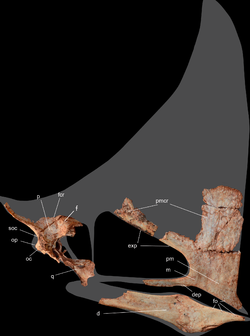ദിനോസർ
ദിനോസൌറിയ എന്ന ജീവശാഖയിലെ പലതരത്തിലുള്ള ഒരു കൂട്ടം ജീവികളാണു
ഡൈനസോറുകൾ അഥവാ
ദിനോസറുകൾ.
ദിനോസറുകൾ ഭുമിയിൽ ആവിർഭവികുനത് ഏകദേശം 230 ദശ ലക്ഷം വർഷങ്ങൾക്കു മുൻപ്
അന്ത്യ ട്രയാസ്സിക് കാലത്ത് ആണ് . തുടക ജുറാസ്സിക് കാലം തൊട്ടു അന്ത്യ
ക്രിറ്റേഷ്യസ് വരെ ഭൂമിയിൽ ഏറ്റവും പ്രാതിനിധ്യം ഉള്ള ജീവിയും ദിനോസറുകൾ
ആയിരുന്നു. എന്നാൽ അന്ത്യ ക്രിറ്റേഷ്യസ് കാലത്ത് സംഭവിച്ച ഭൂമിയുടെ ചരിത്രം
കണ്ട ഒരു വലിയ വംശനാശത്തിൽ (കേ - ടി വംശനാശം) അന്ന് ജീവിച്ചിരുന്ന മിക്ക
ദിനോസർ വർഗ്ഗങ്ങളും നശിച്ചു. ഫോസ്സിൽ തെളിവുകൾ സൂചിപിക്കുന്നത്
ജുറാസ്സിക് കാലഘട്ടത്തിൽ ജീവിച്ചിരുന്ന
തെറാപ്പോഡ എന്ന വിഭാഗം ദിനോസറുകളിൽ നിന്നും ആണ്
പക്ഷികൾ
പരിണാമം പ്രാപിച്ചത് എന്ന്. ഇന്ന് പക്ഷികളെ ദിനോസറുകളുടെ പിൻഗാമികളായ
ഏകവംശമായി തരം തിരിച്ചിരിക്കുന്നു. 66 ദശ ലക്ഷം വർഷം മുൻപ്പ് നടന്ന
വംശനാശത്തിൽ നിന്നും കുറച്ച് പക്ഷികൾ രക്ഷപെട്ടു അവ ഇന്നും ദിനോസറുകളുടെ
പരമ്പരയിലെ കണ്ണികളായി ജീവിക്കുന്നു. .
[1]
വർഗ്ഗം , രൂപം , ആകൃതി ,ജീവിച്ചിരുന്ന പരിതഃസ്ഥിതി എല്ലാം കൊണ്ടും
വ്യതസ്തമായ ജീവികൾ ആയിരുന്നു ദിനോസറുകൾ. ഫോസ്സിൽ തെളിവുകളുടെ അടിസ്ഥാനത്തിൽ
പാലിയെന്റോളോജിസ്റ്റ്മാർ ഇവയെ അഞ്ഞൂറിൽ പരം ജെനുസുകൾ ആയും ,
[2] ആയിരത്തിൽ പരം ഉപവർഗ്ഗം ആയും തിരിച്ചിട്ടുണ്ട്. എല്ലാ വൻകരകളിൽ നിന്നും ദിനോസറുകളുടെ ഫോസ്സിൽ കിട്ടിയിടുണ്ട്.
ഭീകരനായ
പല്ലി
എന്ന് അർഥം വരുന്ന ദിനോസർ എന്ന പേര് തെറ്റിധാരണ ഉണ്ടാക്കുന്നതാണ് കാരണം
ദിനോസറുകൾ പല്ലികൾ അല്ല മറിച്ചു അവ ഉരഗങ്ങളുടെ ഒരു വ്യത്യസ്ത വർഗ്ഗം
ആയിരുന്നു ,
ഉരഗങ്ങളിൽ
കാണുന്ന സ്വാഭാവികമായ സവിശേഷങ്ങൾ പല ദിനോസറുകളിലും കാണാൻ സാധിക്കില്ല
,ഉരഗങ്ങളെ അപേക്ഷിച്ച് മിക്ക ദിനോസറുകൾക്കും നിവർന്നു നിൽകാൻ
സാധിക്കുമായിരുന്നു. ഇത് കൂടാതെ പല പുരാതന ജീവികളെയും പ്രതേക്കിച്ച്
മോസസോറുകൾ ,ഇക്തിയോസൗർ, ടെറാസോറസ്, പ്ലെസിയോസൗർ ,ഡൈമെട്രോഡോൺ എന്നിവയെയും
ദിനോസറുകളായി തെറ്റിധരിച്ചിരുന്നു,
|
ഉള്ളടക്കം
- 1 പേരിനു പിന്നിൽ
- 2 ചരിത്രം
- 3 വലിപ്പം
- 4 ഭക്ഷണം
- 4.1 മാംസഭോജികളായ ചില ഡൈനസോറുകൾ
- 4.2 സസ്യഭോജികളായ ചില ഡൈനസോറുകൾ
- 4.3 പറക്കുന്ന ഡൈനസോറുകൾ
- 5 സാംസ്ക്കാരികം
- 6 ഇതും കാണുക
- 7 അവലംബം
- 8 കൂടുതൽ വായനക്ക്
- 9 പുറത്തേക്കുള്ള കണ്ണികൾ
|
പേരിനു പിന്നിൽ
ഇംഗ്ലീഷ് പാലിയെന്റോളോജിസ്റ്റായ
റിച്ചാർഡ് ഒവൻ1840-ലാണു
ഗ്രീക്ക് ഭാഷയിലെ ഭീകരനായ എന്നർത്ഥമുള്ള ദെയ്നോസ് എന്ന പദവും
പല്ലി (ഉരഗം) എന്നർത്ഥമുള്ള സൗറോസ് എന്ന പദവും കൂട്ടിച്ചേർത്ത് ഡൈനസോർ എന്ന പേരുണ്ടാക്കിയത്.
ചരിത്രം
ദിനോസാറുകൾ ആർക്കോസാറുകളിൽ നിന്നും ആവിർഭവിച്ചത് ഏകദേശം 230 ദശ ലക്ഷം
വർഷങ്ങൾക്കു മുൻപേ മദ്ധ്യ-അന്തിമ ട്രയാസ്സിക് കാലഘട്ടത്തിൽ ആണ്.
[3][4].
ഭുമിയിലെ 95% ജീവികളും നശിച്ച പെർമിയൻ-ട്രയാസ്സിക് വംശനാശത്തിനു ശേഷം
ഏകദേശം 20 ദശ ലക്ഷം വർഷങ്ങൾ കഴിഞ്ഞാണ് ഇത്. റേഡിയോ പഴക്കനിർണ്ണയം വഴി
മനസിലാക്കുന്നത് ഇയോറാപ്റ്റർ ഫോസ്സിലുകൾ ഈ കാലയളവിൽ നിന്നും ആണ് എന്നാണ്.
പാലിയെന്റോളോജിസ്റ്റ്കൾ അനുമാനിക്കുനത് എല്ലാ ദിനോസറുക്കളുടെയും പൂർവികർ
ഇയോറാപ്റ്റർകളെ പോലെ ആയിരിക്കും എന്നാണ് , ഇത് ശരിയാണെങ്കിൽ ആദ്യ ദിനോസറുകൾ
ചെറിയ ഇരു കാലികൾ ആയ മാംസഭോജികൾ ആയിരുന്നിരിക്കണം.
ട്രയാസ്സിക്, ജുറാസ്സിക്, കൃറ്റേഷ്യസ് എന്നീ മൂന്നു പ്രധാന കാലഘട്ടങ്ങളിലാണു ഡൈനസോറുകൾ നിലനിന്നിരുന്നത്.
ട്രയാസ്സിക് (25 കോടി വർഷം മുമ്പേ മുതൽ 20 കോടി വർഷം വരെ)
ജുറാസ്സിക് (20 കോടി വർഷം മുമ്പേ മുതൽ 14.5 കോടി വർഷം വരെ)
കൃറ്റേഷ്യസ് (14.5 കോടി വർഷം മുമ്പേ മുതൽ 6.5 കോടി വർഷം വരെ)
ഇവ നാമാവശേഷമായതിനെക്കുറിച്ചു പല സിദ്ധാന്തങ്ങളും നിലവിലുണ്ട് -
ഉൽക്കകൾ പതിച്ചതുകൊണ്ടോ അഗ്നിപർവതസ്ഫോടനത്താലോ
ഭൂമിയിലുണ്ടായ
മാറ്റങ്ങളാണു ഡൈനസോറുകളുടെ നാശത്തിനു കാരണമെന്നാണു കരുതപ്പെടുന്നത്. ഇന്ന്
ഭൂമിയിൽ കാണപ്പെടുന്ന പക്ഷികളുടെ മുൻ ഗാമികളാണു ഡൈനസോറുകൾ.
വലിപ്പം
രേഖപ്പെടുത്തിയതിൽവച്ച് ഏറ്റവും ഭാരമുള്ളതായി കണക്കാക്കപ്പെട്ടിട്ടുള്ളവ ആംഫിസെലിയസ് (122.4 ടൺ ),
ആർജെന്റീനോസോറസ് (73 - 88 ടൺ ) എന്നിവയാണ്. ഏറ്റവും നീളം കൂടിയവ
ആംഫിസെലിയസ് : 40 - 60 മീറ്റർ (131–198 ft),
സൂപ്പർസോറസ് :
33 മീറ്റർ എന്നിവയുമാണ്. ഏറ്റവും ഭാരം കുറഞ്ഞവയിൽ ആഞ്ചിയോർനിസ് (110
ഗ്രാം ), എപിഡെക്സിപ്റ്റെറിക്സ് (164 ഗ്രാം ) എന്നിവയും ഏറ്റവും നീളം
കുറഞ്ഞവയിൽ എപിഡെക്സിപ്റ്റെറിക്സ് 25 സെന്റിമീറ്റർ , ആഞ്ചിയോർനിസ് 34
സെന്റിമീറ്റർ എന്നിവയും ഉൾപ്പെടുന്നു.

Scale diagram comparing the largest known dinosaurs in five major
clades and a human
ഭക്ഷണം
ചില ഡൈനസോറുകൾ സസ്യഭോജികളും ചിലവ |മാംസഭോജികളും മറ്റു ചിലവ മിശ്രഭോജികളും ആയിരുന്നു.
മാംസഭോജികളായ ചില ഡൈനസോറുകൾ
- റ്റി റക്സ് - റ്റിറാനോസാറസ് റക്സ്
- വെലോസിറാപ്റ്റർ
- സ്പൈനോസോറസ് - ഏറ്റവും വലിയ മാംസഭോജിയായ ഡൈനസോർ
- ജിഗാനോടോസോറസ്
സസ്യഭോജികളായ ചില ഡൈനസോറുകൾ
- ബ്രാക്കിയോസോറസ്
- ഡിപ്ലോഡൊക്കസ്
- ആർജെന്റീനോസോറസ്
- സൂപ്പർസോറസ്
- സ്റ്റെഗോസോറസ്
- ട്രൈസെറാടോപ്സ്
പറക്കുന്ന ഡൈനസോറുകൾ
ടെറാസോറസ് ദിനോസർ വർഗം ആണ് എന്ന് പല സ്ഥലങ്ങളിലും കാണാം എന്നാൽ ഇത് തെറ്റാണ് . ഇവ കേവലം പറക്കുന്ന ഉരഗവർഗ്ഗത്തിൽപ്പെട്ട ജീവികളാണു. പറക്കുന്ന ഒരു ഇനം ദിനോസർ ആർക്കിയോപ്റ്റെറിക്സ് ആണ് .
[5]
സാംസ്ക്കാരികം
സർ ആർതർ കൊനാൻ ഡോയലിന്റെ 1912-ൽ പ്രസിദ്ധീകരിച്ച ദ് ലോസ്റ്റ് വേൾഡ്, മൈക്കൽ ക്രൈറ്റൺന്റെ 1990-ൽ പ്രസിദ്ധീകരിച്ച ജുറാസ്സിക് പാർക്ക് എന്നീ കൃതികളിലും ജുറാസ്സിക് പാർക്ക് (യൂണിവേഴ്സൽ സ്റ്റുഡിയോസ്),
ഡൈനസോർ (ഡിസ്നി) എന്നീ സിനിമകളിലും ബാർണി തുടങ്ങിയ റ്റീവീ സീരിയലുകളിലും ഡൈനസോറുകൾ കഥാപാത്രങ്ങളാണ്.
courtesy:ml








